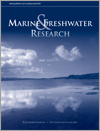Marine and Freshwater Research
Volume 74
Number 2 2023
Rocky reefs are one of the most common and spectacular environments along the coast of New South Wales (NSW). However, this seascape is under threat from suggestions that the black sea urchin should be culled or fished as an invasive species. These urchins are endemic to NSW and create habitats that support a diversity of fishes and invertebrates. Accordingly, urchins in NSW should be appreciated as important contributors to a mosaic of habitats and the removal of them, for whatever purpose, would have to be managed carefully.
Intraspecific diverstity of a fishery resource should be treated as a strategic unit for the sustainable management of fishery resources. Stock identification is one of the important fields in fisheries science and it is gaining importance in India. The review gives baseline data on different methods used and the fishes for which stock-identification study has been conducted. Further, we have highlighted a few issues that need to be considered in the future.
Local ecological knowledge (LEK) has been identified as important to be co-used with scientific knowledge to enhance management of fisheries and local ecosystems. The paper compares local fishers’ LEK and sampled data on fish species composition, ecological preferences, and wellbeing. The fishers’ LEK and survey data showed similar patterns of occurrence of fish species, catch estimates and survey catches. There were also complementary differences in assessing fish wellbeing. The similarities and differences were identified as opportunities to co-identify management strategies.
The eastern and southern sea garfish are two commercially important species with potentially overlapping distributions, differing life histories, and remarkably similar morphological traits. To resolve species boundaries and aid fisheries management, we examined differences in the genetics, body morphology, meristic counts, and inner-earbone shape between the two species. Our integrative taxonomic approach confirmed the overlapping distributions of both species, contextualised the genetic difference of the species pair within their genus, and found new traits to tell these species apart.
Mussels are a healthy source of food, and beneficial for human consumption. Mytilus platensis fishery is an important socio-economic resource in Argentina. This species is also used worldwide as a bioindicator. Increase in bioaccumulation of metals in mussels from an area near harbour produced significant damage on its metabolism. Our results provided useful information on environmental concentrations of trace metals in the northern Patagonia coastline, as well as highlighting a possible human health risk owing to consumption of this commercialised species.
Depth and transparency affect the distribution of macrophytes depending on their life form, by modifying available resources and habitat structure. We showed that in a flooded area of the Atlantic Forest, submerged species exhibit increased frequency and abundance from a determined threshold of transparency, whereas floating species exhibit decreased frequency and abundance from a determined threshold of depth.
The study used passive integrated-transponder technology to describe spawning migrations of common galaxias, with a focus was on understanding the environmental cues that initiate migration. We showed that tagged fish undertook rapid downstream migration up to 50 km from the upper reaches of the system to the lowland reaches near the estuary. Migration was related to increased river discharge and moon phase. Our results fill an important knowledge gap in the understanding of the life history of common galaxias.





